65TH ANNUAL CONFERENCE, Abu Dhabi, 28 April – 2 May 2025WP No. 161Update on Environment Initiatives in EuropePresented by Liaison Officer to SESAR/EASA |
| SUMMARY Air transport has played an important role in improving access and supporting the economic development of many countries and territories. It has driven an incredible expansion in relations between the peoples of the world. The combined effect of liberalisation and fuel and cost reductions has opened up access to long-distance travel for a large proportion of the population in developed countries, and this will continue in the rest of the world. In the coming years, the European air transport sector aspires to be sustainable in the face of the climate challenge and is aiming for carbon neutrality by 2050. This transition will have to be managed by all the stakeholders, from the EU, the government and the different actors in the sector together. The Air Traffic Controllers will be asked to contribute to this societal challenge in their daily job. This can however only be achieved with intelligent and safe measures. |
Introduction
1.1. This update will provide an overview of the ongoing initiatives in Europe to manage the sustainable transition in climate impact assessment on aviation. It also aims to summarize some of the ongoing research activities and highlight some of the latest ideas with regard to different interest groups on what aviation and air traffic control should be doing to assist the endeavour of improving the environmental performance of aviation. Further, it will propose that IFATCA embraces a way forward to how ATCOs should have to handle environmental related procedures. Noise will be mentioned as part of the illustration of the need to have a robust understanding of the impact of the sustainability measures imposed on aviation.
1.2. The paper is split into three parts. Part one will outline the possibilities of contributing to aviation climate neutral growth. Part two will summarize the ongoing European initiatives and Part three will highlight a possible way forward for IFATCA, which could be further studied.
1.3. A Environment TF was created in the past. A first coordination meeting took place after long in December 2024. This TF could be tasked to further assist in elaborating policies, should directors so wish. Alba Cruz (Spain), Benjamin van der Sanden (EVP Tech) Byron Post (South Africa), David Johnson (UK GATCO), Davide Bianchi (Italy), Marc Baumgartner (SESAR EASA coordinator) Roberta Mascherotti (Italy) and Tim Rees (Australia) are currently participating to the TF.
1.4. This report includes links to websites.
Discussion
Part I Aviation contribution to a sustainable future of the planet
2.1. Some sources claim that we are living in the period of Anthropocene. The Anthropocene is term that is used to refer to the period of time during which humanity has become a planetary force of change. The term is widely used in scientific discourse, especially with respect to accelerating geophysical and biochemical changes that characterize the 20th and 21st centuries on Earth (Wikipedia accessed 25.02.2025). Although not officially accepted as a scientific term it is widely used and the start is coined around 1950.
2.2. Thanks to increased measurement capabilities, a raise in the global average temperature can be observed.
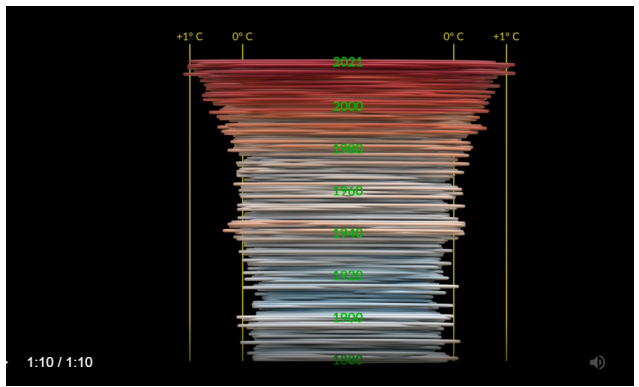
2.3. What started with the Rio Earth Summit, is a United Nations led initiative to create the required political program based on scientific work, which led to the creation of the Intergovernmental Panel on Climate Change (IPCC) which is the United Nations body for assessing the science related to climate change. All the human activities and their respective impact on the increase of the global temperature are being assessed by the scientific community.
2.4. At the political level, different initiatives have been taken, either at the national or international level. At the international level, ICAO has launched CORSIA. The Carbon Offsetting and Reduction Scheme for International Aviation (CORSIA) is the first global market-based scheme that applies to a sector. It complements other aviation in-sector emissions reduction efforts such as technological innovations, operational improvements and sustainable aviation fuels to meet the ICAO aspirational goal of carbon neutral growth.
For international flights in excess of their 2020 level, airlines can purchase ‘carbon credits’.
For an additional payment, their passengers can offset their emissions.
Currently 976 million tons of CO2 are produced by aviation a year and only 20 million tons are offset.
The European Emission Trading Scheme EU ETS, created in 2005, wanted to initially include on a mandatory basis aviation as well. This was however opposed and thus the airlines prefer to participate to CORSIA which is non-binding. Initially foreseen for all the flights in the European Union, it was argued by airlines in Europe, that this would result in a market distortion. After lengthy negotiation, a compromise was found and thus airlines do not participate actively in the EU ETS for the time being.
2.5. The European Union, under the first van Leyen Commission, created the European Green Deal. This political initiative was broken down into different subinitiatives touching upon different sectors.
2.6. As aviation contributes to the warming of the global temperature by producing CO2 and non-CO2 emissions, the challenge for aviation is to reduce its global footprint. Experts agree that aviation currently contributes to 2-3% of the overall CO2 production of all human activities. The contribution to non-CO2 emissions is for the time being scientifically not sufficiently robust and can therefore not be quantified. As the forecasted global traffic increase of aviation is raising between 3-5% per year the impact on the overall CO2 production is identified as being negative.
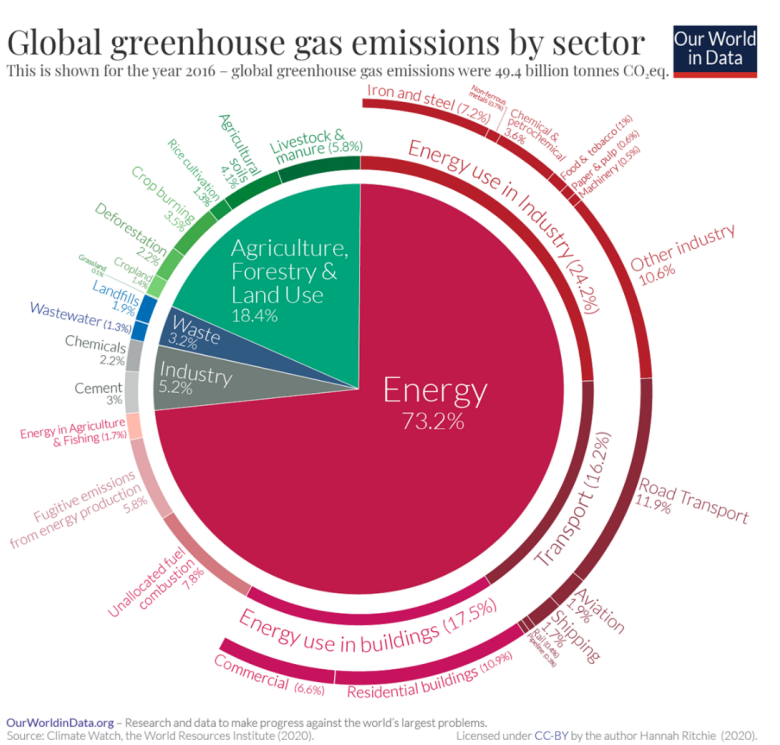
2.7. To decarbonize is the main challenge for aviation. When talking* about decarbonization, the following elements arementioned:
(a) a sharp reduction in aircraft fuel consumption;
(b) the use of alternative fuels to kerosene;
(c) carbon capture and storage**, ***
(d) sobriety.
* https://academieairespace.com/wp-content/uploads/2024/03/AAE_Avis20_UK_WEB.pdf
** Note: These alternative fuels are called Sustainable Aviation Fuels (SAF). They are produced either from bio sources (bio-SAF), or from CO2 and hydrogen… and a large amount of electricity (e-SAF/e-fuel).
*** Note: For general aviation and short-haul aircraft with less than 100 seats, “all-electric” or “hybrid” or “hydrogen” alternatives seem interesting (see below). to “neutralise” emissions from the remaining fossil kerosene.
a) The acceleration in the replacement of aircraft fleets by recent aircraft (average age 12 years) and the appearance of a new generation of aircraft around 2035, will provide successive gains of 30 % and 25 % respectively in fuel consumption per passenger-kilometre-transported (pkt). Given that medium- and long-haul flights of more than 1,500 km departing from Europe generate over 70 % of CO2 emissions, it is on these flights that action must be taken as a priority.
b) Various SAF (Sustainable Aviation Fuels) variants compatible with current aircraft are in the early stages of industrial production and will enable a safe transition thanks to their like for like capability. SAF from bio-based sources have many advantages, but the quantity available in Europe for aviation will amount to only 20% of requirements. Consequently, the use of a large quantity of e-fuels (Electrofuels, also known as e-fuels, are a class of synthetic fuels which function as drop-in (like for like) replacement fuels for internal combustion engines. They are manufactured using captured carbon dioxide or carbon monoxide, together with hydrogen obtained from water splitting. Electrolysis is possible with both traditional fossil fuel energy sources, as well as low-carbon electricity sources such as wind, solar and nuclear power (Wikipedia accessed 07.03.2025)) is a necessary step, and will call for a great deal of decarbonised electricity.
c) Measurable, certifiable carbon capture and storage operations will generate 3 negative emissions” that offset the emissions from the remaining use of fossil kerosene on a tonne-for-tonne basis (This 20% figure is confirmed by a report by the French Académie des Technologies, June 2023: “La décarbonation du secteur aérien par la production de carburants durables” – https://shorturl.at/xGIKW).
2.8. The Eurocontrol Performance Review Commission published in June 2024, the Performance Insight #9, where it estimates the potential benefit for Air Traffic Management of reducing CO2 due to ATM work to 9.3% (note that the benefit pool will never go to 0%).
2.9. The biggest gains in CO2 from the current operations are for flights above 1500km. IFATCA in the past has requested the Network Manager to establish a program to manage the CO2 trajectory for the European Network. The NM has not been working on this.
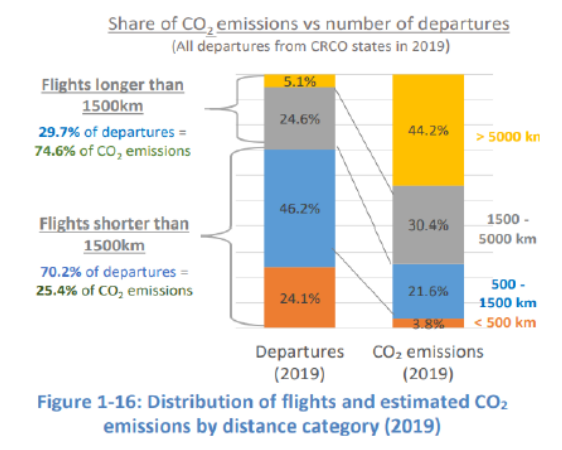
2.10. ATC can plan a certain role in assisting future CO2 trajectory by providing a safe service along the routes. An ATCO has, however, only limited possibilities to reduce the CO2 impact of a flight if only addressing the portion of the flight through their airspace. Initiatives like Free Route in Europe are providing at a systemic, flight planning level, the opportunity to systemically reduce the flying distance of an aircraft. However, a lot of operational uncertainties tend to reduce the CO2 related benefits.
2.11. With regard to non-CO2, the ATCO might as well be asked to influence a planned trajectory by providing a certain form of advice. Science is, however, not mature enough to be sure what is being done to influence the non-CO2 trajectory is not counterproductive. See comments in part 2 and 3 of this paper.
2.12. Regarding Noise abatement, a large experience exists throughout Europe and it has become part of the daily job of Tower and Approach controllers. This working paper will not discuss the issue of noise abatement procedure in part I.
Part II European initiative regarding environment
2.13. Several EU regulations call upon different sectors of transport to increase transparency with regard to CO2, non-CO2 and use of SAF.
2.14. Commission Regulation 2018/2066 requires aircraft operators to monitor and report their greenhouse gas emissions. This is mandatory for CO2 since 1.1.2021 and for non-CO2 since 1.1.2025.
2.15. Commission Regulation 2018/2067 specifies the need for verification and the mutual recognition of the verifier.
2.16. EU Regulation 2023/2405 on ensuring a level playing field for sustainable air transport (ReFuelEU Aviation). This regulation is in force since 1.1.2024 and It sets requirements for aviation fuel suppliers to gradually increase the share of SAF blended into the conventional aviation fuel supplied at EU airports.
2.17. Since the inception of the Single European Sky, Environment has been part of the Key Performance Areas of the Performance Regulation. The European Commission is publishing European Targets, which are then broken down to national targets. Two indicators have been created.
2.17.1. During RP3, (EASA 2025) environmental performance has been measured through one KPI, namely horizontal en-route flight efficiency of the actual flight path (KEA). KEA measures the additional distance flown in comparison to the great circle distance (shortest distance between two airports).
The higher the KEA inefficiency value, the worse the performance. However, other factors such as wind, weather, airspace structures, and network constraints influence the optimum trajectory. One of the objectives of the SES2+ proposal from the Commission, was to develop a more suitable KPI on
environmental performance for RP4. However, due to the duration of the negotiations and adoption of the SES2+ legislation, this was not possible and is now planned for RP5.
2.17.2. The Performance Scheme includes various indicators that are only monitored at either EU-level or local level but with no binding targets. These include the average horizontal en-route flight efficiency of the last filed flight plan trajectory (KEP)2 and the shortest constrained trajectory (KES/SCR).
2.17.3. As with all other indicators, KEP and KES/SCR have been significantly affected by the war in Ukraine leading to general increases of inefficiency during 2022 and 2023, although there has been a reduction in the delta between KES/SCR and KEP. As with KEA, it is recognized that more suitable indicators are needed to give a clearer indication on the effectiveness of ANSP and Network Manager actions.
2.18. Under the Single European Sky, the Technological pillar includes the SESAR Joint Undertaking. Plenty of stakeholders work around the ATM Masterplan to research future technology which will assist in the modernisation of the European Airspace. The European ATM Masterplan outlines the research axes and sustainability and green ATM have a prominent place in the masterplan.
Current research to enable greener flights ongoing under the SESAR umbrella include the following projects:
2.18.1. Green-GEAR- Green operations with Geometric altitude, Advanced separation and Route charging Solutions.
IFATCA participates to the Advisory Board of Green-GEAR.
2.18.2. AEROPLANE- Advancing Measures to Reduce Aviation Impact on climate and enhance resilience to climate-change
IFATCA has requested to join the Advisory Board.
2.18.3. E-CONTRAIL- Artificial Neural Networks for the Prediction of Contrails and Aviation Induced Cloudiness.
No IFATCA involvement.
2.18.4. CICONIA- Climate effects reduced by Innovative Concept of Operations – Needs and Impacts Assessment.
IFATCA has joined the Stakeholder Consultation Body and is represented by Alba Cruz and Roberta Mascherotti.
2.18.5. DYN-MARS- Dynamic Management of Aircraft Configuration and Route Structures.
No IFATCA involvement.
2.18.6. CONCERTO- Dynamic Collaboration to Generalize Eco-friendly Trajectories.
No IFATCA involvement.
2.18.7. GALAAD- Green Aviation – Lean Arrivals And Dynamicity.
No IFATCA involvement.
2.18.8. GEESE- Gain Environmental Efficiency by Saving Energy.
No IFATCA involvement.
2.18.9. HERON- Highly Efficient Green Operations.
No IFATCA involvement.
2.19. Parallel to the SESAR Joint Undertaking, the European Union has as well, a Joint Undertaking called CLEANSKY. As this Joint Undertaking looks predominantly at the airborne parts (engine, fuel, electric etc.), IFATCA is not involved.
2.20. The European Aviation Safety Agency EASA, has created a European Network on the Impact of climate change on aviation (EN-ICCA). IFATCA participates in this Network with Byron Post, Alba Cruz and Roberta Mascherotti. Based on the IPCC assessment report No 6, the EN-ICCA works on phenomena like storms, hurricanes, heatwaves, heavy precipitation, flooding and drought.
2.21. Eurocontrol, together with ACI, has created the European Aviation Climate Change Adaptation Working Group. IFATCA is represented by Alba Cruz and Roberta Mascherotti.
2.22. Different publications are available on these topics.
- EASA, EC and Eurocontrol have published the European Aviation Environmental Report (EAER 2025)
- the EACCA WG has published the Adaptation Aviation to Changing Climate.
2.23. Regarding contrails avoidance, IFATCA had lately the opportunity to exchange with two NGOs.
- Breakthrough Energy
- Transport and Environment
Both organisations claim that contrail avoidance can be managed. In the discussion we found out that the scientific basis used by both organisations are the same as the ones known to IFATCA. Thus, some of the product sold to airlines to avoid contrails are scientifically not robust enough.
With the Monitoring, Reporting and Verification obligation regulated by EC Regulation 2018/2066 and 2018/2066, airlines will have to report non-CO2 emissions and thus there is a certain interest to avoid contrails, in order not to have to report them. NGOs have positioned themselves with sometimes challenging opinions, recommendations and reports towards EU Politicians. These lobbying activities might create an additional operational impact which is not recommended by IFATCA. Teaming up with the European Cockpit Association has provided IFATCA with further insight into the ongoing political activities.
2.24. D-KULT is a DLR lead initiative on predicting contrails and together with Lufthansa trial flights were conducted. No results are known so far.
2.25. Eurocontrol Maastricht UAC together with DLR has conducted trials in the past, and it is our understanding that new trials are starting again. The scientific basis for these trialsis not robust enough to avoid contrails.
PART III a possible way forward for IFATCA
2.26. The impact on Air Traffic Management of the Environment actions needed to meet the different decarbonisation initiatives of the Aviation sector can be split into the following categories:
- ATM Infrastructure
- ATM Operations
2.27. Under ATM infrastructure, the following sub-categories have been identified so far:
- Energy, IT, building, travel
- Reduce to net zero operation
- Commuting of Staff
- Offsetting the IT energy consumption
- Solar panel and wind energy for remote sites
2.28. Under ATM Operations the following categories have been identified so far:
- Free route airspace
- Horizontal flight efficiency
- Vertical flight efficiency
- Noise abatement procedure
- Taxi out time
- Continuous climb/descent
- Contrail avoidance
2.29. The ENV TF is cognisant of the fact that PLC has discussed the current IFATCA policy on environment (2011) and the ENV TF wishes to contribute to this discussion with the following suggestion, based on the European experience.
Under the SESAR contract, IFATCA and other Professional Staff Organisations had the possibility to produce a position paper on environmental issues. Largely inspired by the IFATCA policy this paper (see annex) is called Aviation Sustainability – Human Operators approach and considerations about the ATM component.
The main request from the staff organisations were:
Ensure that the level of safety shall be maintained or improved when environmentally-driven procedures are introduced;
- Ensure that all individual environmental factors are identified and considered while establishing procedures.
- The actual values (noise levels, fuel consumption and the level of emissions) of the various individual environmental contributors of new or existing procedures should be established in detail for transparency purpose.
- The interrelation of the various individual environmental factors should be identified and addressed.
- IFATSEA propose to add ANS/ATM systems, services, architecture and configurations are ensuring the required resilience and QoS to enable operational efficiency and green operations.
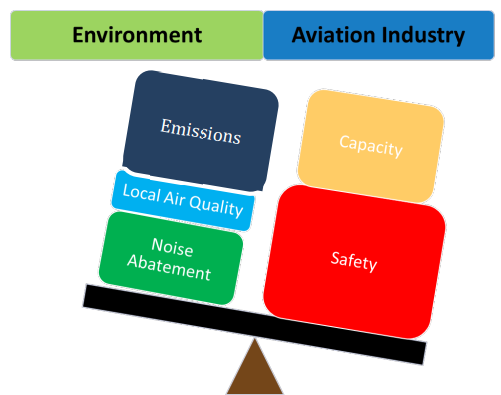
2.30. The position paper further requests an ‘environment cases’ in the same way we have ‘safety cases’ for all the changes in the ATM system.
Provisions for an environment case should comprise at least the following requirements:
- An environment case is a documented body of evidence that provides argument that a certain procedure is optimised for all individual environmental factors as prioritised by the appropriate authorities.
- An environment case should provide a detailed overview to the appropriate authorities for the determination of priorities of the individual environmental factors on a strategic level.
2.31. Further, the position paper argues that the front end-user (ATCOs, Pilots and ATSEPs to a certain extent) can manage the impact of environmentally driven procedures in a safe and efficient way. Thus, it was proposed to use the ICAO conflict management layer (ICAO, Doc 9854) when introducing new environmental procedures (including noise, CO2 and non-CO2). IFATCA, since the publication of this paper (2021), has repeatedly called upon the Eurocontrol Network Manager to manage the CO2 trajectory for flights above 1500km, as it is illusionary to leave the management of a CO2 trajectory by individual ANSP or ATS units. As the non-CO2 (contrails) (Non-CO2 avoidance, measurement and scientific evidence can be found in https://academieairespace.com/wp-content/uploads/2024/03/AAE_Avis20_UK_WEB.pdf chapter 4 p. 41 ff) avoidance is scientifically on very insecure ground, IFATCA has not yet been able to identify the best vehicle to cross-border manage the areas prone for contrail formation.
2.32. The ICAO conflict management layer was created by ICAO during the discussion leading to the Global ATM Concept. This conceptual approach (see annex to this paper) is very helpful as it argues for a clear separation of strategical, tactical actions when introducing new procedures of any sort.
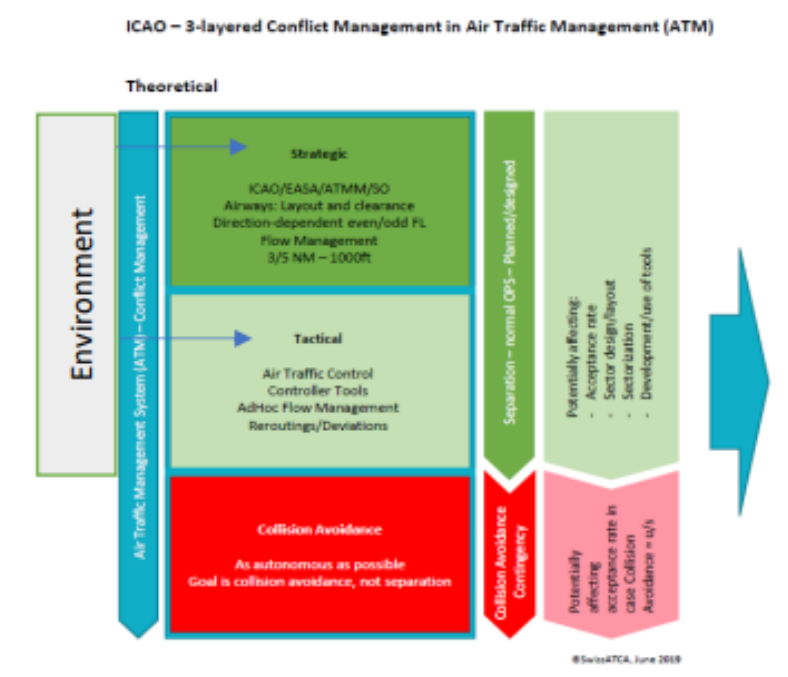
2.33. Three examples chosen randomly to illustrate what this means in the daily work of an ATCO:
- At an airport, noise abatement procedures have to applied by the ATCOs during certain hours of the day. The ATCO, needs to be trained to apply this specific procedure, the controller working tool needs to be able to display the noise sensitive zones and an altitude indication shall be displayed on the map. This is all carried out on the strategic level. Asking the ATCO to apply the noise abatement procedure on a tactical level (meaning without training and the needed ATCO assistance tools), is not only hazardous but contra-productive for the noise abatement procedure.
- Non CO2 avoidance trial not communicated to ATC units. During the D-KULT trials, the pilots were instructed, based on a very unscientific flight planning tool, to stick to their flight plan to avoid contrail formation. Pilots refused headings and level changes instructed by the ATCO, as the ATCOs were not informed.
- It is our understanding that MUAC Eurocontrol leaves at a tactical level the choice to the ATCO to apply contrail avoidance or not. These avoidance actions are not properly trained, no visual assistance is provided to the ATCO.
Conclusion
3.1. IFATCA has an Environmental policy which is being reviewed by PLC.
3.2. The ENV Taskforce has met once in 2024 for a virtual meeting.
3.3. European activities on Environment are led by the European Commission and have a significant impact on Air Traffic control.
3.4. IFATCA has been able to contribute to the Environment discussion by participating to SESAR Research, discussion with regulators and agent such as the Network Manager.
3.5. IFATCA in Europe calls for action at the Network Manager level to manage the CO2 trajectories for flights with a length of above 1500 km as a priority.
3.6. IFATCA, together with other Professional Staff Organisations, has published a position paper called Aviation Sustainability – Human Operators approach and considerations about the ATM component. (see attachment to this paper)
3.7. IFATCA argues that any environmental procedures need to be introduced at the strategical level using the ICAO 3-layer conflict management model.
Recommendations
4.1. That educational material for ATCOs is created by the ENV TF explaining the environmental challenges. This material could take the form of courses, educational videos, etc.
4.2. That the IFATCA Environmental policy insists on the application of any environmental measure to be located on the strategic layer of the ICAO conflict management model layer.
Annex: Aviation Sustainability – Human Operators approach and considerations about the ATM component
Position paper by Professional Staff Organisations (PSOs: ATCEUC, ECA, ETF, IFATCA, IFATSEA).
October 2021 (pp. 13-28).


